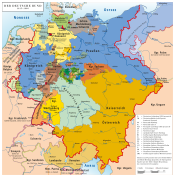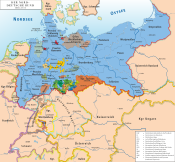|
Grand Duchy of Oldenburg
The Grand Duchy of Oldenburg (German: Großherzogtum Oldenburg, also known as Holstein-Oldenburg) was a grand duchy within the German Confederation, North German Confederation and German Empire that consisted of three widely separated territories: Oldenburg, Eutin and Birkenfeld. It ranked tenth among the German states and had one vote in the Bundesrat and three members in the Reichstag.[1] Its ruling family, the House of Oldenburg, also came to rule in Denmark, Norway, Sweden, Greece, Russia[2] and United Kingdom. HistoryThe Grand Duchy of Oldenburg came into existence in 1815 combining the territory of the old Duchy of Oldenburg with the Principality of Birkenfeld. Whilst Oldenburg was elevated to a grand duchy at the Congress of Vienna, the first two grand dukes continued to style themselves as merely dukes and it was not until 1829 that the newly acceded Augustus used the title of grand duke. Although paternalist, the early grand dukes did not grant a constitution until events overtook them in 1848. The European RevolutionsOldenburg did not entirely escape from the Revolutions of 1848 that swept across Europe, but no serious disturbances took place therein. In 1849 Augustus granted a constitution of a very liberal character to his subjects. Hitherto his country had been ruled in the spirit of enlightened despotism which had been strengthened by the absence of a privileged class of nobles, the comparative independence of the peasantry, and the importance of the towns; thus a certain amount of friction was inevitable. In 1852 some modifications were introduced into the constitution, yet it remained one of the most progressive in the German Confederation. Important alterations were made in the administrative system in 1855 and again in 1868, and government oversight on church affairs was ordered by a law of 1863. In 1863, Peter II, who had ruled since the death of his father Augustus in 1853, seemed inclined to press a claim to the vacant Duchy of Schleswig and Duchy of Holstein, but ultimately in 1867 he abandoned this in favor of the Kingdom of Prussia and received some slight compensation. In 1866 he had sided with Prussia against the Austrian Empire during the Seven Weeks War and joined the North German Confederation. In 1871 the grand duchy became a state of the German Empire.[2] Oldenburg remained a monarchy until the German Revolution of 1918-1919, when the last grand duke, Frederick Augustus II, abdicated and Oldenburg became a constituent state of the Weimar Republic as the Free State of Oldenburg. Gallery
See alsoSources
Works cited
|
||||||||||||||||||||||||||||||||||||||||||||||||||||||||||||||||||








